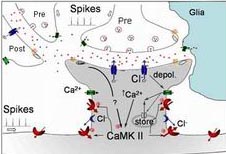
Signaling mechanism underlying GABAg receptor-independent LTP at developing GABAergic synapses
The brain is "plastic" as it is constantly changing. The ability to learn and form memories is due to the ability of neurons to change the way in which they communicate with each other - that is, through synaptic plasticity. As a major inhibitory neurotransmitter in the brain, GABA plays an important role in neuron transmission network. However, GABAergic synapses have only come into the limelight recently, and plasticity of GABAergic synapses remains largely unexplored, especially in developing animals.A recent study by CAS researchers may shed light on the issue.
As being reported 26 Oct. online by
Nature Neuroscience, graduate students XU Chun and ZHAO Man-xia, under the supervision of Drs. Mu-ming Poo and ZHANG Xiao-hui from the Institute of Neuroscience, the CAS Shanghai Institutes for Biological Sciences, have made advancements on their studies of GABAB receptor activation mediates frequency-dependent plasticity of developing GABAergic synapses.
In this study, the researchers have demonstrated a critical role of GABAB receptors (GABABRs) in frequency-dependent synaptic plasticity of developing hippocampal GABAergic synapses, during early postnatal development when they are still excitatory. They further reveal the cellular mechanism underlying the frequency-dependent long-term potentiation (LTP) induced by coincident pre- and postsynaptic neuronal spiking-Three coincident events, postsynaptic spiking, GABAAR activation and GABABR activation are required, which, in turn, result in up-regulation of postsynaptic CaMKII activity and local activity of a Cl- co-transporter NKCC1, leading to the strengthened GABAergic transmission (Figure).
These findings reveal a novel function of GABABRs in the postsynaptic regulation of long-term plasticity of developing GABAergic synapses, and such frequency-dependent plasticity also provides a mechanism for self-refinement of local GABAergic circuits during neural development.







